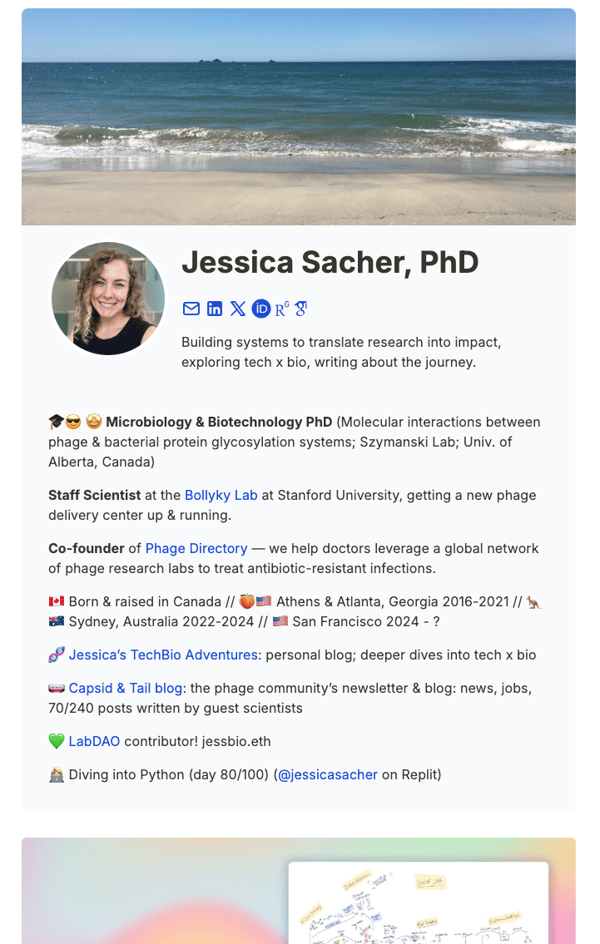Hi everyone,
It’s getting darker and colder outside! Being in California (like Sydney) means it’s easy to forget what it’s like in many parts of the world — cold and wintery! Though we’re now sometimes wearing sweaters, it’s still about 15-20°C ish most days. It’s also easy to forget what’s going on when you’re heads down in work!
Jess is working hard in the lab, and I’ve been building prototypes of various data and research tools in prep for Phage Option 2024, the phage conference in Colombia coming up soon. We’re polishing these up and fixing bugs along the way, but here’s a sneak preview of one of our tools — Breakdown.
Breakdown uses OpenAI’s GPT-4o to break any news article or research paper down into its base arguments and critiques. It does its best to cite its sources from the articles itself. It does a decent job, and can make some papers (e.g. Machine Learning and bioinformatics) papers much easier to read and understand.
We’re still squashing bugs and adding features like multiple languages, but you can try it out here (https://breakdown.labspace.ai/).

We’re also making progress on our profile page system, which is a cross between a personal blog, Linkedin page, CV/resume, and link in bio.
Eventually we want everyone to have their own professional websites, based on their CV and Linkedin, that they can share with others at conferences or when looking for their next position.
Check out Jessica’s personal CV page (https://jess.bio) and Atif Khan’s personal CV page (https://atif.phage.directory/). We’re currently making it easier for people to set up their own accounts, and (finally) be able to edit their own accounts!

Here’s what we published this past month:
by Jessica Sacher
In this interview between Jessica and Jesus Fernandez from Eligo Bio in France, they talk about how Eligo figured out how to use modified phages to perform base editing of E. coli and Klebsiella — within the mouse gut — without killing the bacteria! Very very cool, and something they deserved a Nature paper for.
Nature: https://www.nature.com/articles/s41586-024-07681-w
Spotify Podcast: https://open.spotify.com/episode/5ybZX5A8bAYGsrkyt9iZrK?si=eUvuoiNDSoaXTg56vKnMRg
by Kate Kelly
Last month, Kate Kelly, a high school senior, spent 30 days interning at the Bollyky Lab at Stanford (where Jessica currently works). At the lab, she learned various techniques like bacterial inoculation, plaque assays, flow cytometry, and fluorescence recovery after photobleaching (FRAP), and her main project involved dyeing phages to observe diffusion in biofilms. In this article, she reflects on her experience in the lab.
by Jan Zheng
In this month’s Phage Picks, we highlighted a very well-written post-mortem on Achaogen’s (a former biotech that made antibiotics) demise, and how expensive and difficult putting a new drug on the market is. I also found a neat review paper on atypical (non-dsDNA phages), and a preprint describing a new method for designing phage-based biosensors with novel protein systems on PDMS surfaces. That last one was a doozy.
by Ritah Nakayinga
In this guest article by Dr. Nakayinga, she describes how Banana Xanthomonas Wilt (BXW), a disease caused by Xanthomonas vasicola pv. musacearum, is ravaging banana crops across Uganda. Current management practices are expensive and ineffective, and at this rate could lead to 100% crop loss. Dr. Nakayinga is leading a project at Kyambogo University to develop phage-based biocontrol methods against BXW, where they’ve already isolated phages showing 70-100% efficacy. They’re now working on formulating a phage cocktail and testing effectives in the field!
C&T Throwback!
C&T Throwback!
I honestly can’t believe it’s been almost exactly a year we’ve been using ChatGPT for work. Where’s the time flown? Seriously. We have so many thoughts on how to use AI for research, and they might not be what you think. We barely use AI to write any text for us!
Mostly we use AI as a partner for thought — from understanding research papers, to searching for information, to formatting data, to writing and refactoring code. We also build it into tools that we use daily (like Breakdown, which I shared above!). If we use it for writing, mostly for those what’s that word again…? moments, or for spell checking. If you’ve noticed, we’ve chose to write more casually, and in our own voices. That’s one of the few ways left to tell that you didn’t just ask ChatGPT or Claude to write everything for… might even leave in a typo ro two. AI after all rarely makes typo mistakes!
We’ll try to get another AI for Work article to you before the end of the year. The year’s almost up, but there’s still so much left to do! Here’s looking forward to November!
~ Jan & Jessica









